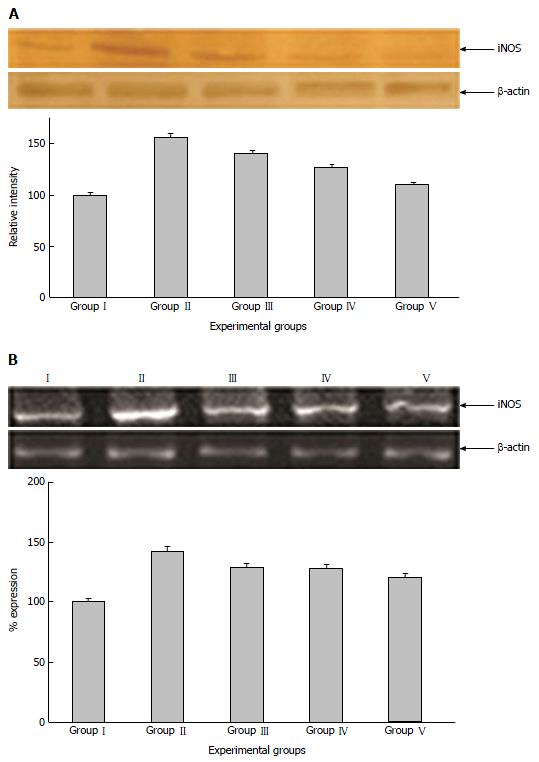Copyright
©The Author(s) 2016.
Figure 2 Immunoblot expression of inducible nitric oxide synthase in control and experimental group of animals (A) and effect of hesperdin on inducible nitric oxide synthase gene expression in the eye lens of Wistar rats exposed to galactose (B).
A: Lane I, eye lens protein from control (physiologic saline) rats (Group I); lane II, eye lens protein from galactose administrated rats (Group II); lane III, eye lens protein from animals administered with galactose and 25 mg/kg body weight hesperidin simultaneously (Group III); lane IV, eye lens protein from animals administered with galactose and 50 mg/kg body weight hesperidin simultaneously (Group IV); and lane V, eye lens protein from animals administered with galactose and 75 mg/kg body weight hesperidin simultaneously (Group V). The separated lens protein was preincubated with anti-iNOS polyclonal IgG antibody (1:500 dilution) and subsequently with goat antirabbit IgG-HRP (1:3000 dilution).The immunoreactivity was developed with 0.01% DAB and H2O2. β-actin refers to housekeeping protein expression and its levels are constant across all treatment groups indicating the normal behaviour of lenses under various treatment. The figure clearly shows increased iNOS protein expression under galactose mediated oxidative stress. This increased iNOS protein expression was prevented by hesperidin in a dose dependent manner; B: Lane I, mRNA expression in lens from rats treated with saline alone (GroupI); lane II, mRNA expression in lens from rats administered with galactose alone (Group II); lane III, mRNA expression in lens from rats administered with galactose and hesperidin 25 mg/kg body weight simultaneously (Group III); lane IV, mRNA expression in lens from rats administered with galactose and hesperidin 50 mg/kg body weight simultaneously (Group IV); lane V, mRNA expression in lens from rats administered with galactose and hesperidin 75 mg/kg body weight simultaneously (Group V). Galactose-mediated oxidative stress causes an increase in the expression of iNOS gene, which probably underlies the pathogenesis of cataract induced by galactose. All these changes were prevented by hesperidin simultaneously, indicating its protective effect. iNOS: Inducible nitric oxide synthase.
- Citation: Manikandan R, Arumugam M. Anticataractogenic effect of hesperidin in galactose-induced cataractogenesis in Wistar rats. World J Ophthalmol 2016; 6(1): 1-9
- URL: https://www.wjgnet.com/2218-6239/full/v6/i1/1.htm
- DOI: https://dx.doi.org/10.5318/wjo.v6.i1.1









